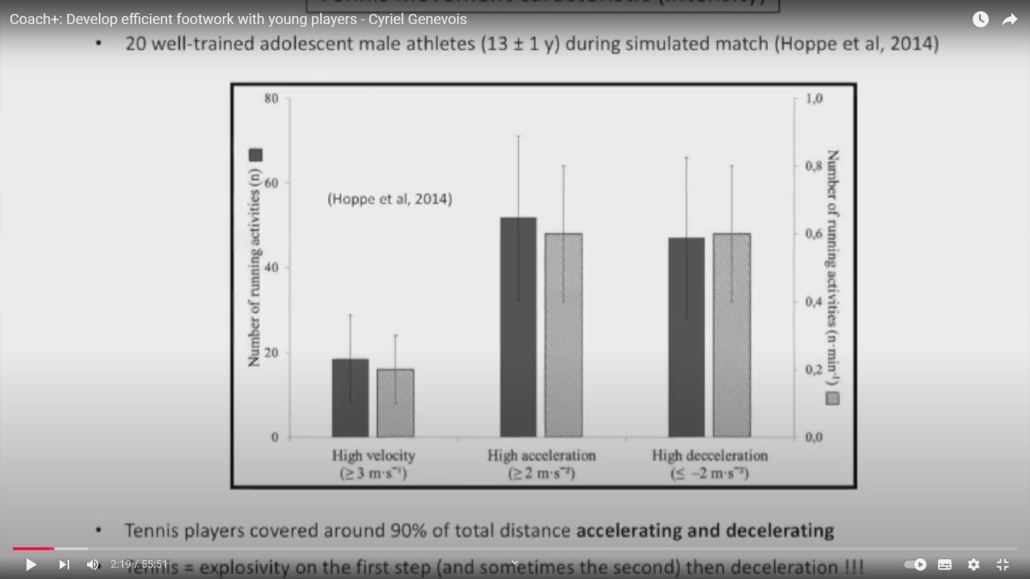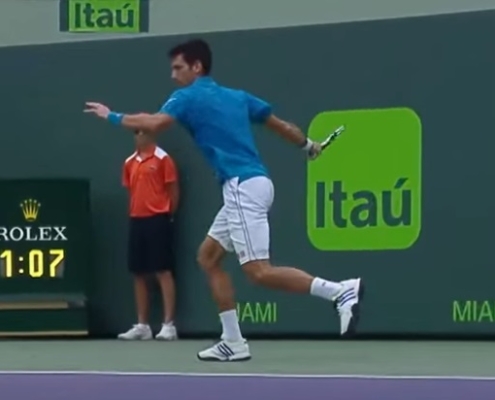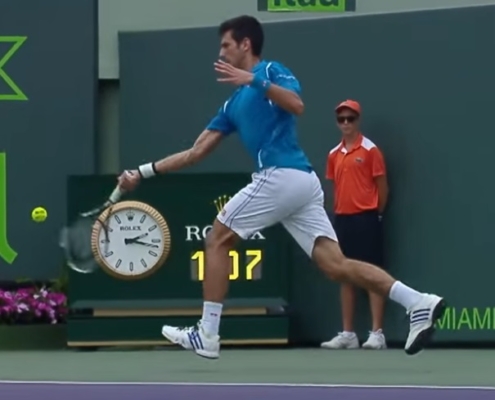Not all Jumps are created Equal
Dear coach,
I wanted to update you on a couple of recent developments in the APA Method. I periodically revisit the APA Homepage and the “About APA” section – which you can read here to hold myself accountable to the vision I have for the company. As part of the 2025 Vision to be the Best Tennis S&C team in the World it has been my personal mission to evolve the Strength, Power and Speed methods to ensure our athletes are getting the best possible service, what I call APA 2.0. Today I’d like to discuss some of my recent thoughts on lower body power methods. If APA 1.0 is our High Performance Training Method, then APA 2.0 is the fine tuning that enables us to squeeze the juice out of our most elite performers using highly targeted assessment and training means.
Lower Body Power – Bounding & Skill Mill
- 3 Hop as an assessment of single leg force capacity and ability to key positions important for deceleration and general movement
- Relevance of bounding as a more representative task that closely approximates the reciprocal nature of limbs in running
- Use of non motorised treadmill to assess Absolute Peak Power Output (PPO) in locomotive task to compliment vertical jump assessment of PPO
In today’s blog I would like to update on progress on 3 Hop and Bounding, with a bit of a review on why are think they are important test, how we are using them and how they link to our use of the Speedworks P, S, R system.
If you haven’t got time to read the full article now, be sure that you can find out all about the topics discussed in this blog (and more!) at my next “Speed & Agility for Tennis” Coach Development day hosted by speedworks in December.
Anyway, back to the blog!
Introduction
The stretch-shortening cycle (SSC) is a natural variation of muscle function found in conventional human movements. In sports, one common modality to improve SSC performance is through plyometric training. The countermovement jump (CMJ), squat jump (SJ), drop jump (DJ), hopping and bounding are the most commonly used movements to assess SSC exercise performance and lower limb power.
YET…….. when training or assessing individuals, exercise selection is CRITICAL as movement SPECIFICITY may influence the degree of the relationship and transference into performance.
Now, before you think this is going to be another debate about training specificity just hear me out! Regardless of the exercise choice, sprint performance relies on strength, power and stiffness of the leg muscles and also higher levels of reactive strength. It’s why I decided to partner with speedworks, as I truly believe that sprinting is the ultimate movement screening tool! I also believe that single leg plyometrics are more specific to the movement demands of tennis and sprinting in general.
Matthew McInnes Watson of PlusPlyos aka “The Plyo Guy” put me onto this idea of looking at momentum being one of the main things that we want to monitor in our plyometrics. Verkoshansky’s fundamental theory of plyometrics pointed out straight away that you need initial momentum, and you need an airborne phase to initiate truly plyometric elastic capabilities within an athlete. When we are looking at incoming momentum and how that affects outgoing momentum we are able to understand a larger picture of reactive strength/elastic strength.
In terms of overall specificity we need to look at specificity from a broader perspective. In order to understand an exercise’s level of specificity, we need to take account of:
- ADAPTATION specificity – muscle motor unit recruitment (force), tendon stiffness, CSA etc
- ATHLETE specificity – age, gender, stage of development, Athlete type – more force or elastic driven?
- SPORT specificity – common actions within the sport – more acceleration or max speed, in terms of jumping: more 2 leg take off and landing, 2 to 1, 1 to 1, more sagital plane, transverse/frontal plane, more horizontal or vertical etc?
In terms of specificity to tennis the large exertion of propulsive force during acceleration is more relevant. Check out this excellent introduction from Cyril Genevois below:
A few key points:
- More than 70% of movements in elite tennis are lateral
- 80% of movement is less than 2.5m, less than 5% is more than 4.5m
- You don’t have time in tennis to reach high velocities so the most important thing in tennis is to be able to accelerate and decelerate
- Evolution of the movement pattern of the split step: landing with two feet simultaneously is out of date!
- Now, elite players react in the air during the split and land on the foot furthest from their intended direction
So what?
The split step is not the same as it was 30 years ago. We need to react on a single leg, so you need what we call “single leg reactive strength” to move on this first step by reacting on the outside foot (the “start” phase).
This means that on the split step there is greater activity for ankle extensor muscles of the outside leg compared to the other one before landing to better use the stretch-shortening cycle during the first lateral movement.
Then it is a matter of lower body explosive strength to produce some force on the first two steps (the “move” phase). Note that this is where I’m thinking the “bounding” exercise fits in the “move” phase. It teaches cyclical expression of explosive strength; it teaches you to move! Then to stop it’s eccentric strength. Then when you hit the ball it’s a combination of strong stabilisation and upper and lower body power (the “hit” phase). Then in change of direction it’s single leg reactive strength and finally re-acceleration you need explosive strength (the “recover” phase). All of these phases involve cyclical action of the lower extremities with an emphasise on unilateral repetitive movement.
One final side point on the above “Footwork Cycle.” It’s easy to understand it as START – MOVE – HIT – RECOVER when you imagine that every ball we move to we can stop behind and hit the ball while being stationary. In reality most of the shots that a tennis player hits “on the move” require deceleration of the legs AFTER contact with the ball, so after the hit. That’s why I put the 3 hop & stick as part of the APA plyometric series for “braking strength” within the hit part of the footwork cycle. It’s where the highest braking forces will typically be; after hitting a wide ball on the move, where you decelerate after contact.
Below is an example of the 3 hop & stick:
Check out Roger Federer below doing what is known as the hit and shuffle (or hit & cross over if the legs cross), more commonly known as the “mogul” move. As he transfers his weight onto his left foot after he hits the ball he uses it somewhat like the “penultimate step” of a braking step in a 180 degree cutting action.
So getting back to the “move” phase, in terms of power exercises and plyometrics in particular, what are the PHYSICAL exercises we can do to improve the [tennis] movement to the ball? I have come more and more to the realisation that just as sprinting (and acceleration in particular) requires the need to generate great propulsive horizontal forces with a short contact time, so too do we need to think about this in our jump programme. Today I’ll look at a more linear orientated plyometric activity that we are using to prepare our tennis players for the demands of full court coverage when hitting on the run. I’ll look at some of the more frontal plane orientated plyometrics in another post, which will speak to the split step and recovery actions which rely on lateral hip strength.
Specificity of bounding to sprinting
Compared to other forms of exercise, bounding and hopping can provide specificity for sprinting due to their ability to generate great propulsive horizontal forces with a short contact time, which is important for production of high levels of power. Furthermore, bounding emphasises the rectus femoris muscles during the forward leg swing which is critical for producing forward accelerative forces. Also, this exercise is performed unilaterally and respectively, replicating actual sprinting movements.
As with all exercises, you can do them in different ways, with different intentions, in order to achieve different outcomes. Now the speed coaches would argue that true bounding is specific to the late acceleration phase of sprinting. In my opinion, if you do what I call “long bounds” over distances of 20-30m for 2-3 sets I’m going to introduce that early in the general preparation period because I want to focus on submaximal effort (think extensive method in terms of intensity) with the goal of learning how to maximize the number of take-offs without increasing the magnitude of voluntary force efforts (keep it relaxed and bouncy!). Later on in the preparation period I can do what I call “short bounds” over distances of 10-20m performed at maximal effort (think intensive method) with the goal of maximizing the power output of leg propulsion movements, without increasing the ground contact time. We have come up with the 4-fold leap test as a tool to measure your maximal effort elastic capabilities – more on this test later!
I can hear the tennis coaches saying, well if tennis players only need to be really good at accelerating over the first two steps, how relevant is bounding to tennis, if it is going to enhance acceleration over 10-30m?
But remember, I’m not trying to chase sport specificity necessarily. The whole reason I decided to introduce bounding into the APA Plyometric framework was because I saw the utility of it to address athlete specificity. You can have athletes who are more force driven or more elastic driven, right? I would call this more projection focused or switching focused. From my experience of profiling multiple tennis players using the speedworks PSR framework of Projection, Switching and Reactivity, I’ve seen a trend for tennis players to be projection dominant but poor in switching. This means they are very good at displacing their centre of mass forward and so will probably be good at the projection aspect of the bound but don’t make big shapes and really attack the ground beneath them from above.
The bound also has an “air time” component and I see the bound as a great tool to invite players to be more elastic and specifically use that air time to improve their switching ability. To make a big shape, which is what switching is all about, the bound will allow you more time in the air; you will have a swing through (in the air), some time to think about what you’re doing to do with your foot and then you’re going to put it down. This will enable you to attack down from above and round out your overall athletic profile by giving you a greater level of switching capability.
My thought process: Length & Air – projection dominant – pullers – fast SSC – good at ATTACKING – Links to Bounding
Key point: if you can agree with me, that rounding out an athlete’s overall speed profile to be more proficient across all aspects of sprinting efficiency is important for long term development and robustness, then you will agree that you can’t do this by only replicating the movements that they already do all the time in their sport, and probably for that reason are more dominant in?
For tennis I’m in favour of a “power bound” more commonly known as a bound-for-distance, as it’s more relevant to early acceleration. In a typical 10 bound series, a distance achieved of 20m or less would be considered sprinting, and a distance of 27m would be considered a bound for distance, with speed bounding being somewhere in the middle. To promote the power bound at APA we measure distance as the KPI and cue to “bound as far as possible.” As a test, we would measure distance achieved over 4 bounds. The distance-focus task will alter the mechanics of the foot landing, where heel makes contact first with the ground (ie., this technique can be called “stepping”), thus promoting higher braking impulses, instead of using the ball of the foot as in speed-bounding. But, it’s for this reason that I prefer the power bound, because tennis players do move across the court using a heel-toe action.
Here are a few videos so you can see the difference between a speed bound and a power bound:
In the video below you can see one of our interns performing three bounds over 10m. The coach happens to be an elite sprinter and this was a submaximal effort for him as I asked him to go easy, given he was wearing running shoes on an indoor tennis court. But it gives you an idea.
I’m in favour of the power bound as I feel it’s very strongly related to the jump such as the squat jump indicating the need for explosive power in the hips (think projection of your body forward). I also think that the typical stride length and pattern which you might say would promote “over striding” if the goal was to prepare for a proper leg recovery at top speed, is more close to how elite tennis players cover the width of the baseline when they are hitting on the run!
We are also trialling something I’m calling the 4-fold leap test, again you can see what it looks like below. There is more focus on gaining distance so you don’t get such a noticeable attacking of the knee down so you can really rip the leg forward.
Obviously with the tennis leap, the focus is on horizontal projection, keeping your hips and centre of mass closer to the ground, whereas on the 4-fold leap test you are getting a more aggressive vertical displacement seen in the higher knee drive. The main benefit is that the leap promotes the heel to toe weight transfer and teaches the feeling of taking bigger more powerful steps.
If you wanted to perform a more “tennis specific leap” you would just limit the running steps to two before you then initiate a leap on the outside leg and land on the inside leg, which would definitely make more sense to do in the later preparation phase where you are overloading the actual high-powered tennis action of the “running forehand.” But as I said before, the benefit of doing repeated bounds is you get that repetition of the feeling of the heel to toe weight transfer and the opportunity to make bigger shapes and improve switching capability.
One final thing to point out is that the way an athlete will approach the task will give you a great insight into how they like to produce power – are they more force dominant or are they more velocity dominant? It’s a bit like watching someone perform a counter movement jump – the “contact time” dominant athletes who are very “reactive” will only take a small dip before exploding up, and get off the floor quickly. Compare this to the “jump height” dominant athletes who are very strong and will take a lot more of a dip to maximise their muscle strength. This allows them more time in contact with the ground to generate a higher velocity at take off and so ultimately a higher jump height, albeit at the cost of a longer jump phase. These same athletes might be called “projection” dominant using the speedworks training system nomenclature.
You see the same expression of power seen in the 4-leap test, where those athletes who rely on more muscle strength will yield more at the ankle, knee and hip versus the more reactive athletes who won’t. So there is lots of versality in how you modify the distance and time constraints to invite the athlete to solve the problem using different movement strategies to develop the qualities you want to improve in them. I see the power bound as an important tool in the tennis S&C coaches’ toolbox.
Enjoy the full clip of Djokovic in full flow – the running forehand shot is around the 12 second mark of the video
Hope you have found this article useful.
If you have made it to the end, then be sure that you can find out all about the topics discussed in this blog (and more!) at my next “Speed & Agility for Tennis” Coach Development day hosted by speedworks in December.
Date: Saturday 14th December 2024
Time: 11:00-15:30pm
Location: Loughborough University
Remember:
- If you’re not subscribed yet, click here to get free email updates, so we can stay in touch.
- Share this post using the buttons on the top and bottom of the post. As one of this blog’s first readers, I’m not just hoping you’ll tell your friends about it. I’m counting on it.
- Leave a comment, telling me where you’re struggling and how I can help
Since you’re here…
…we have a small favour to ask. APA aim to bring you compelling content from the world of sports science and coaching. We are devoted to making athletes fitter, faster and stronger so they can excel in sport. Please take a moment to share the articles on social media, engage the authors with questions and comments below, and link to articles when appropriate if you have a blog or participate on forums of related topics. — APA TEAM








